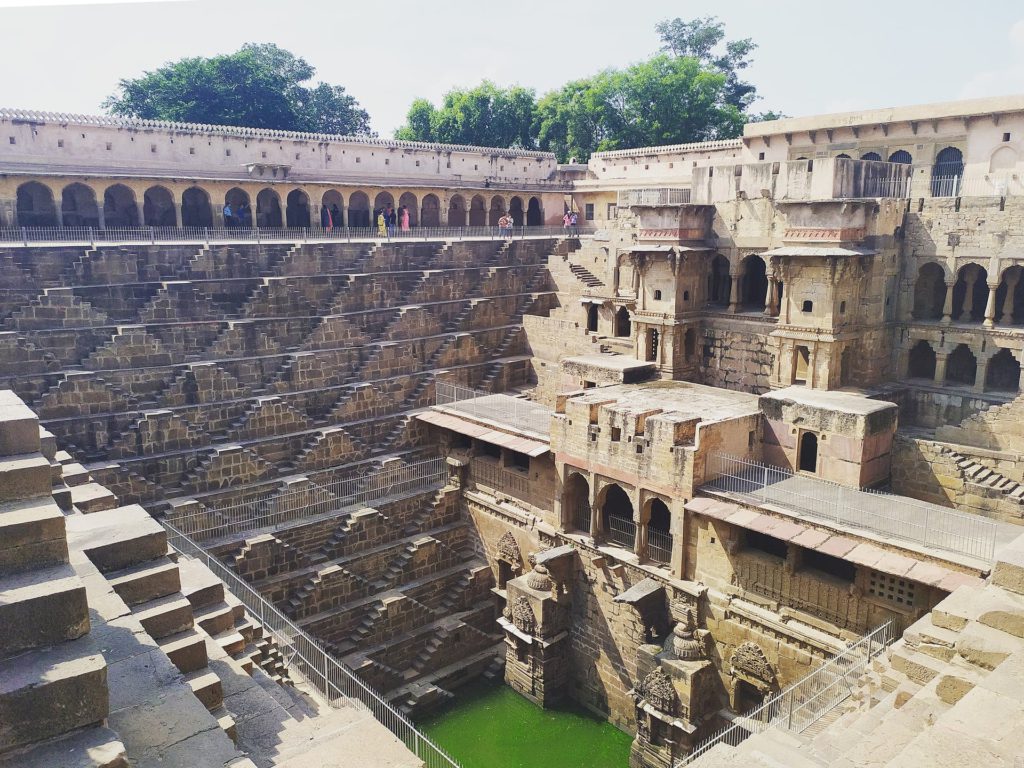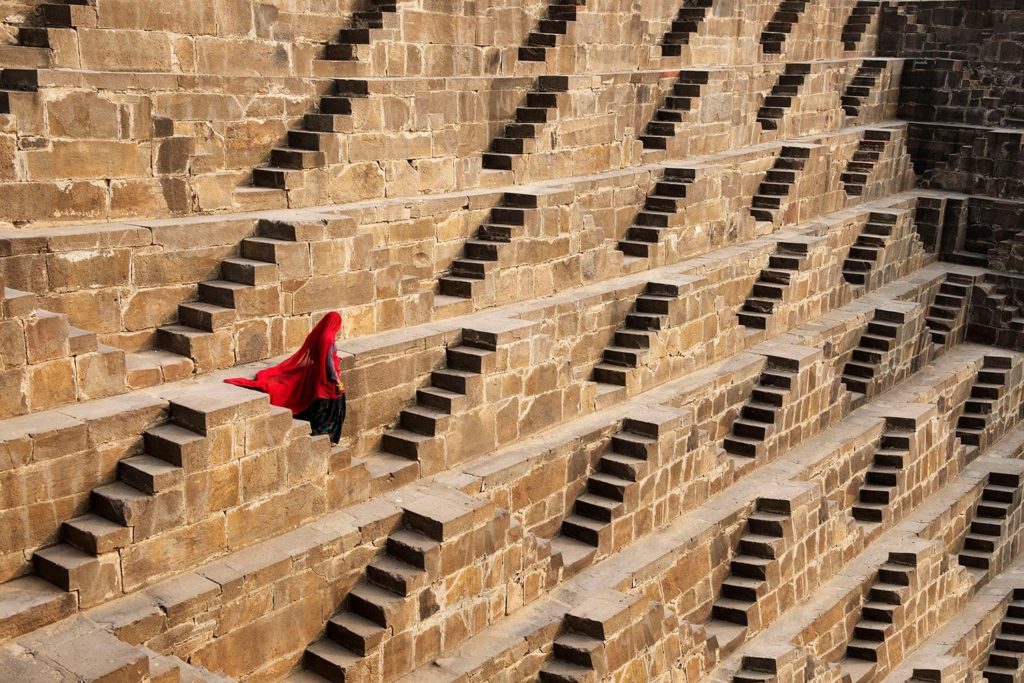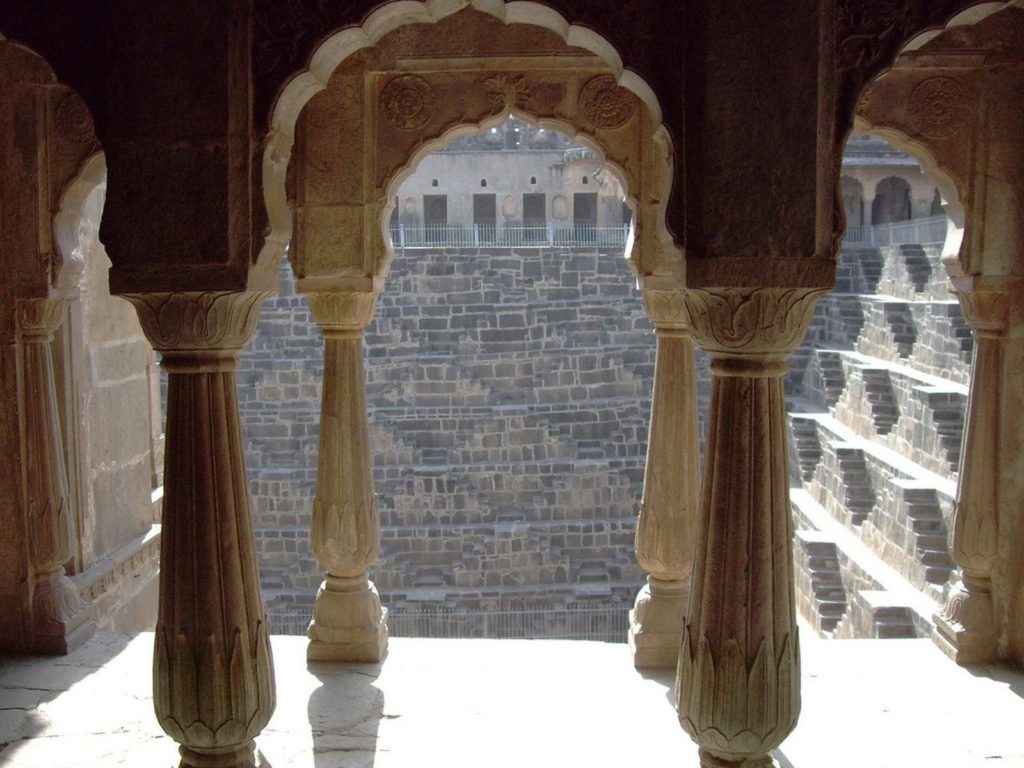Immense architectural gems embedded deep in the Earth like upside-down fortresses scattered across India – restoring them could be the solution to help those suffering from drought.
An exquisitely carved labyrinth of 3,500 steps, arranged in perfect symmetry, descends with geometric precision to the bottom of the well. A crisscrossing staircase surrounds the water on three sides, and the fourth side is decorated with a pavilion with galleries and balconies. Built back in the 8th-9th century during the Rajput period by Lord Chanda, Chand Baori in Abhaneri, Rajasthan is the largest and deepest well in India. Stretching over 13 floors (about 30 meters), it is a fascinating example of inverted architecture.
Sunk into the ground, step wells like Chand Baori have been built in drought-prone regions of India, providing communities year-round access to vital water storage and irrigation systems. However, centuries of natural decline and neglect pushed these buildings into oblivion. The stepped wells, built more than 1,000 years ago, are fading into oblivion. But in recent years, many of these ancient structures have been restored to help solve India’s acute water problem. Like many other countries, India is currently facing the worst water crisis in its history. There are hopes that the ancient technology of step wells can improve the situation. Despite the heavy rainfall during the monsoon season, more than 70% of India’s surface water is unfit for consumption due to pollution. In terms of water quality, India ranks 120 out of 122 countries. According to estimates, 200,000 people die every year due to lack of water.
In a country where roughly half the population faces severe water shortages on a daily basis, any viable solution to water harvesting is a harbinger of hope. “As India’s water table is rapidly declining, step wells can help recharge groundwater aquifers and collect runoff. Millions of liters of water can be collected in three months during the rainy season,” says Ratish Nanda, director of projects at the Aga Khan Trust for Culture. , which is engaged in the restoration of ancient buildings.
In 2018, the government of Rajasthan, one of the driest regions in the world, with technical assistance from the World Bank, developed a comprehensive framework for the rehabilitation of step wells, including Chand Baori. Residents of the district, who raise cattle in Rajasthan, have already noticed a change. “We had to walk for hours in search of water,” they say. “Now we can use the water from the revived baoli in our villages for domestic use, as well as for feeding and washing livestock.”
In the city of Jodhpur, the Turji well has been restored after a team spent months pumping out stagnant water. Decades of toxic water turned the red sandstone that covered most of the well’s surface into white. And solving this and other problems took several years of painstaking work and a lot of money. Currently, about 28 million liters of water per day is supplied to the city from other newly cleaned step wells for irrigation and domestic needs.
With the help of volunteers from local residents and other communities, Gram Bharati Samiti (Rural Development Society), a non-profit organization in Jaipur district, Rajasthan, has carried out restoration work on seven step wells in Rajasthani villages, providing around 25,000 people with more reliable water source of water.

The time of creation of step wells dates back to 2500-1700 BC. They were originally built as crude trenches, but between the 11th and 15th centuries slowly evolved into engineering marvels. In 2016, the coordinates of about 3,000 existing wells in India were mapped. The capital city of Delhi alone has 32 step wells. In 2019, the Aga Khan Trust for Culture, in partnership with the German Embassy in India, restored a well in the Humayun’s Tomb complex in Delhi.
Constructed of masonry, rubble, or brick, step wells involved the careful placement of long steps and side projections around a trench that provided access to the water. During the rainy season, the trench turned into a huge cistern with water, which was filled to capacity. The dense construction of the well helped to reduce evaporation.

Oriental wells are a repository of Indian historical stories that were used for social gatherings and religious ceremonies. They served as a cool place for travelers, as the temperature below was often five to six degrees cooler. Helped create goodwill among thirsty travelers and locals, and provided communities with water. They are an ingenious system for collecting rainwater and serving as a reservoir for it. The revival of step wells can be a significant step in the fight to overcome the water shortage.
Writer Victoria Lautman in her book “Vanishing Steps of India” describes ancient wells as “gateways to the underworld”.

“These are unique buildings because we usually look up at architecture, not down,” she says. “Looking at the front steps, over which tall columns hang, creating changing landscapes thanks to the powerful play of light and shadow. It still fascinates with its beauty behind mystery”.
За матеріалами BBC Future









